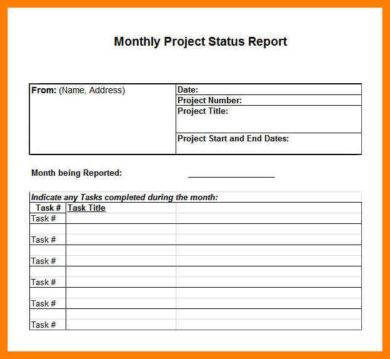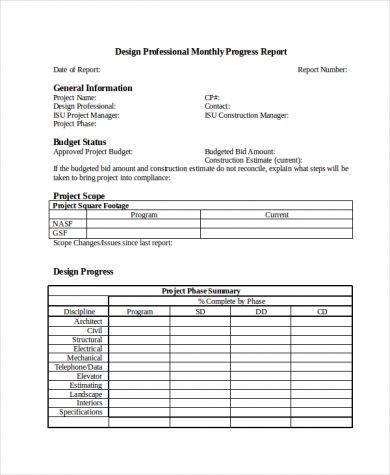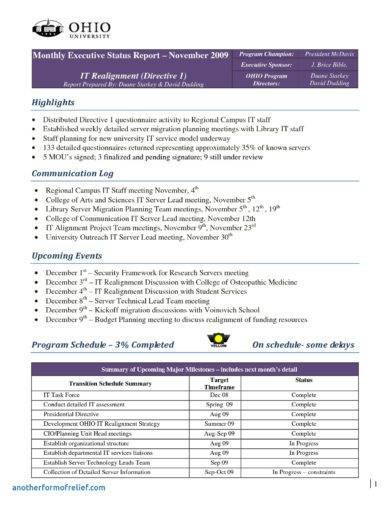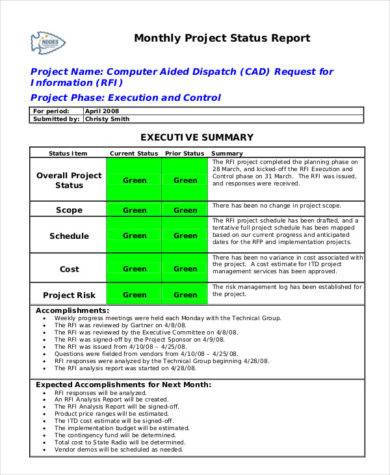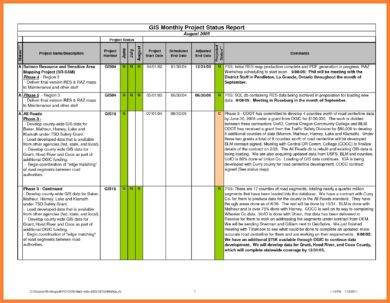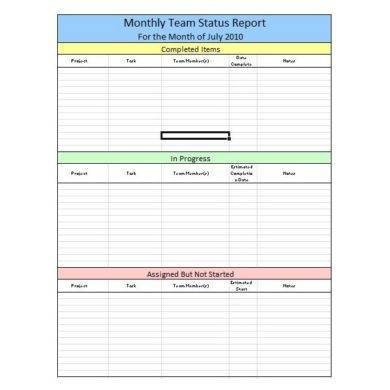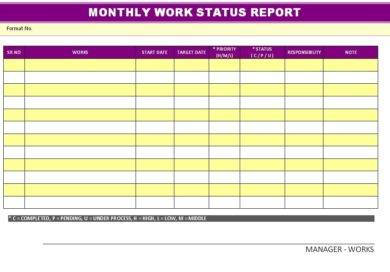9+ Monthly Status Report Examples to Download
Every member of an organization plays a key role in its existence. While executives and managers are given the excruciating task of making major decisions for the company, the rest of the team is held responsible for providing valuable reports to their superiors. You may also see report writing examples.
One of these reports includes the monthly status report. A set of organized and consistent reports will help the organization keep their strategy on track to generate positive outcomes. And while it may take some time to perfect the process of developing a good report, there are a few guidelines that can help minimize the errors.
Business Monthly Project Status Report Example
Design Professional Project Status Report Example
Monthly Executive Status Report Example
The Basics of a Monthly Status Report
In general, reports provide knowledge to members of a team regarding their latest progress on a daily, weekly, or monthly basis.
This includes the team’s accomplishments, plans, and problems on a certain period of time, allowing them to prioritize tasks and issues that need to be addressed immediately. Some companies produce daily status reports to record their day-to-day progress, while other organizations use the report’s alternatives: the weekly status report and the monthly status report.
Unlike daily status reports, weekly and monthly status reports should contain complete and precise details about a task or project. These reports are used to highlight occurrences and issues within the specified time frame.
The only difference that lies between the two general reports is that a monthly status report does not require as many details as a weekly status report does. It provides managers with a higher level view of the developments in a project for better analysis.
Here, stakeholders would typically assess the budget, expenditures, output quality, risks, challenges, and issues that affect the project. This also gives clients a heads-up on project updates, which may either be positive or negative news for the investor. You may also see management report examples.
Since a business and a client may not always meet up on a regular basis, the monthly status report will then serve as a primary medium of communication between the two parties, which is why it must stay as detailed as possible. You may also like business report examples.
Oftentimes, a monthly status report is given to a supervisor or manager to offer an update on general plans and activities of employees. This is used to document an employee’s work history, and may serve as a good reference for performance reviews done annually. Project managers are usually required to turn in the document within one week after the month ends.
The report will also be used to monitor activities to prevent any loopholes that may have been missed.
Monthly Project Progress Report Example
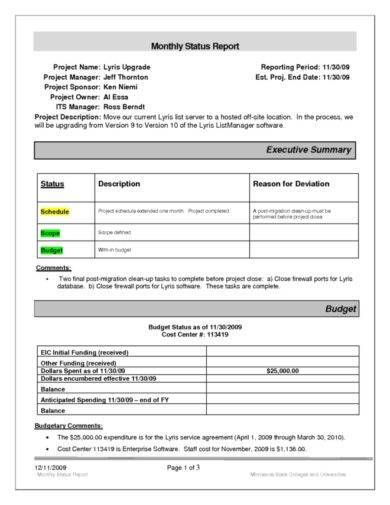 otcc.us
otcc.usMonthly Project Status Report Example
Monthly Project Status Report Template
Monthly Status Report for Business Example
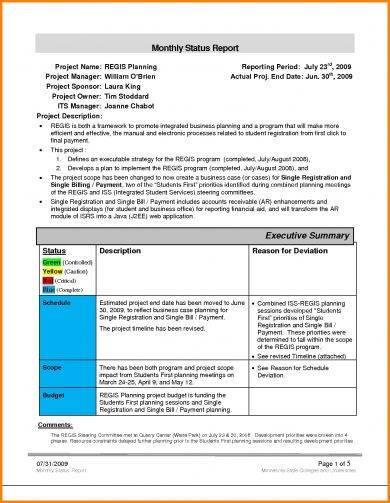 soulhouronline.com
soulhouronline.comWhat to Include
One thing that many project managers seem to struggle with is the components of the report itself. To help you out, here’s a list of the basic elements of a monthly status report:
1. Cover Page
The cover page is usually added to the report for appearance purposes. A branded cover can help reinforce the brand and make it look a lot more professional. You can use a company logo or seal to take the report to the next level.
2. Mission, Vision, and Value
Every organization is defined by its own mission, vision, and value statements. This is used to strengthen the organization’s image and provide direction for its members to follow. If staff members across departments fail to recognize these statements, then your strategy is likely to bring in results that’s far from satisfying. Hence, including these general statements at the beginning of your basic report will help reimpose the organization’s identity and overall strategy.
3. Table of Contents
Formal documents that consist of over 20 pages may require a table of contents to keep it organized. This is because the document may be difficult to navigate through, especially when a manager is trying to locate a specific section. This part of the report must be inserted at the beginning of the document after the entire report has already been written. You may also see project report examples.
4. Scorecard Views
One of the reasons why a management team relies heavily on a monthly status report is because it contributes to the decision-making process. A high-level overview of the organization or department’s scorecard makes it easier to make decisions based on reliable information. You may also like examples of short report.
It should briefly explain the current status of each objective for better analysis. This is also used to link measures and initiatives to illustrate what the management team must come into terms with before a problem becomes even bigger for them to handle. You may also check out investigation report samples and examples.
5. Detailed Pages
Any vital information that must be stated in the report is typically found in this part of the document. At least one page of the status report is dedicated toward the objectives or strategic goals that must be met for the project to be completed. After which, the following pages should relay information regarding the project, such as a brief analysis, a few recommendations, and details on the supporting metrics.
6. Charts
Standard charts provide a visual representation of quantitative data for managers to examine. However, it’s important to keep these charts as accurate and relevant as possible. It must be easy to translate, consist of clear targets, and should remain consistent throughout the report. This will guide leaders in developing better activities and alternatives to help strengthen the foundation of the project.
7. High-Level Project Overviews
Most status reports are created to review strategic-based projects that affect an organization’s overall operations. This is why it’s important to include an overall status update on the vital aspects of the project, along with critical details such as the completed percentage and the budget spent so far. Other critical information may be stated in the formal report, but must be discussed thoroughly during project review meetings with clients and stakeholders.
8. Action Items
The purpose of a simple status report is to review your current strategy and to take action. For this reason, it’s important to have a place to capture action items and major decisions from your meetings. While not everything may be included in the report itself, you may prepare a separate document to record these project discussions and changes.
Monthly Team Status Report Example
Monthly Work Status Report Example
Simple Monthly Status Report Example
Things to Remember when Writing a Monthly Report
A monthly status report plays a vital role in communicating your achievements and ongoing projects for managers to assess. A solid status report must be kept brief, but also comprehensive enough to convey the right message. This includes a list of major activities along with the actions taken, as well as the professional goals set for the upcoming month.
Here are few guidelines to bear in mind when creating a monthly report:
1. Title and Label
You need to ensure that the person who receives your basic report knows exactly what’s being handed over to them. Otherwise, they might end up forgetting or setting the document aside until they can finally settle other priorities. But considering the importance of a status report, you need to make sure they read it before another month ends.
Be sure to title and label the report correctly. Aside from that, it must also state the time covered by the report, the date of submission, and the department or team name that you belong to, and your name as the author of the simple report. It’s best to consult with your supervisor or manager whether there’s a template that must be followed, or if the department has any preferences about how the report should be constructed.
2. Present Accomplishments and Statuses
To keep the report short and to the point, it’s best to use a bulleted list to properly present all that has been achieved during the month. It should also relay information regarding the current status of ongoing projects. Make sure to be specific with these details to prevent any misinterpretations. You need to be honest with your successes and failures, though the negatives may taint your performance review, hidden problems could cause serious effects in the long run.
3. Goals for the Month
Goal-setting is one of the most important parts of any business document. But since this is the type of report prepared on a monthly basis, you only need to focus on the specifics (short-term goals with long-term effects). A few SMART goals that are tailored according to the organization’s mission is essential for overall success.
However, try not to turn it into a lengthy discussion of who and what, or you may end up with a long list of goals that are nearly impossible to achieve within the given time frame.
A Summary
If necessary, you can also provide a summary of where things are with you and your team. A closer look into the organization’s internal sectors will help emphasize issues that must be settled before anything goes out of hand. Personal challenges may also be mentioned for the manager to provide further assistance when needed. You may also see service report examples.
You can also mention small victories that have contributed to the team’s successes for the month, along with the struggles that have caused disappointing productivity levels for you and the rest of the group. Make sure to name the people who have assisted you or the team in your endeavors as well. You may also like financial report examples.
Additionally…
Apart from the general components of a monthly status report, your supervisor may request for a few additional information to include in the document. For instance, you may be asked to provide a financial summary regarding the department’s expenses for the months. You can do so by presenting your numbers in a table. Be sure to meet up with your supervisor to obtain supporting documents that may help you construct a credible report. You may also see marketing report examples.
Fact checking is incredibly crucial. Any false statements included in the report may cause significant damage to a project, as well as to the author’s professional standing in the organization. Also, remember to review previous reports before you begin crafting a new one. An outline of the major events involved in the project will demonstrate your progress, therefore leaving you with an overview of a project’s status. You may also like quality report examples.
Monthly reports are an important document that can assist a business in generating successful outcomes for its projects. This will help keep stakeholders engaged and update managers on the latest occurrences involving staff members and project statuses. But to get a high-quality report, you must employ the necessary procedures involved in developing a report. With these guidelines and examples, you’re sure to come up with a thorough monthly status report in no time!



